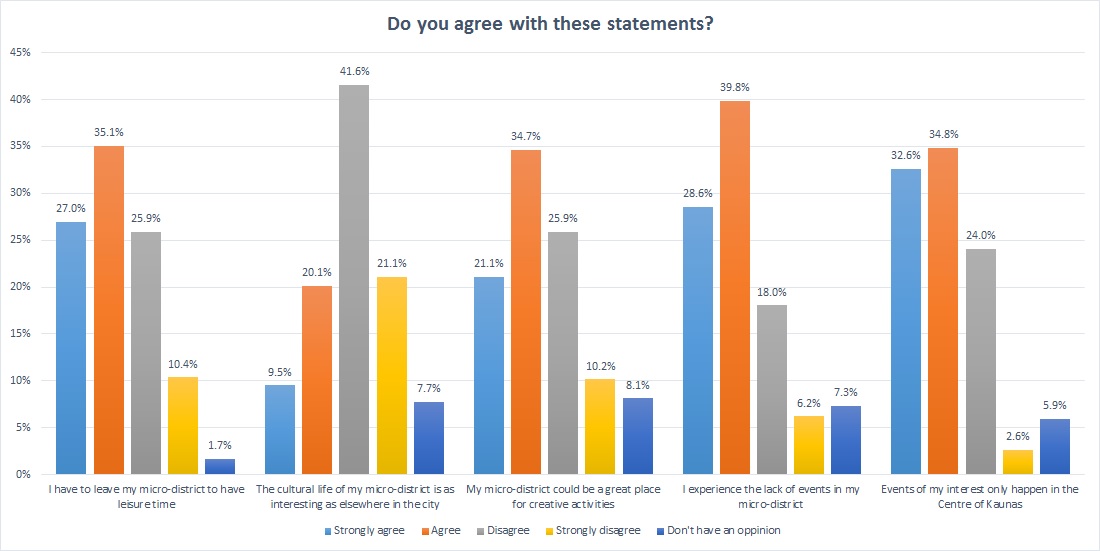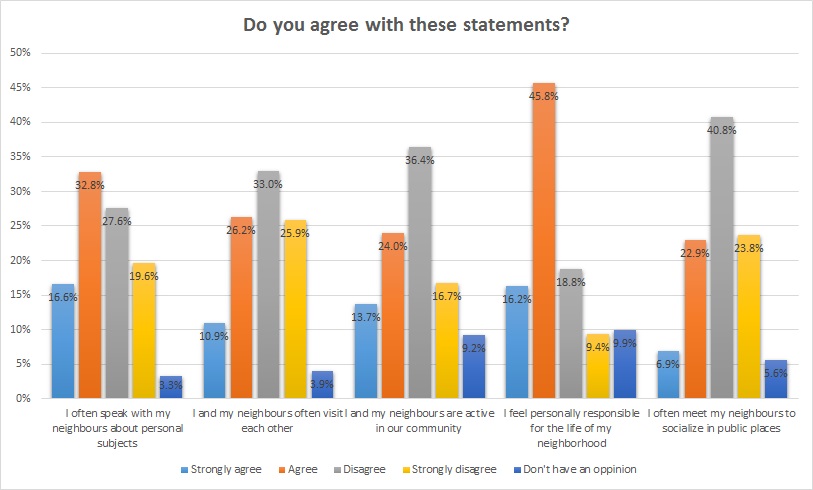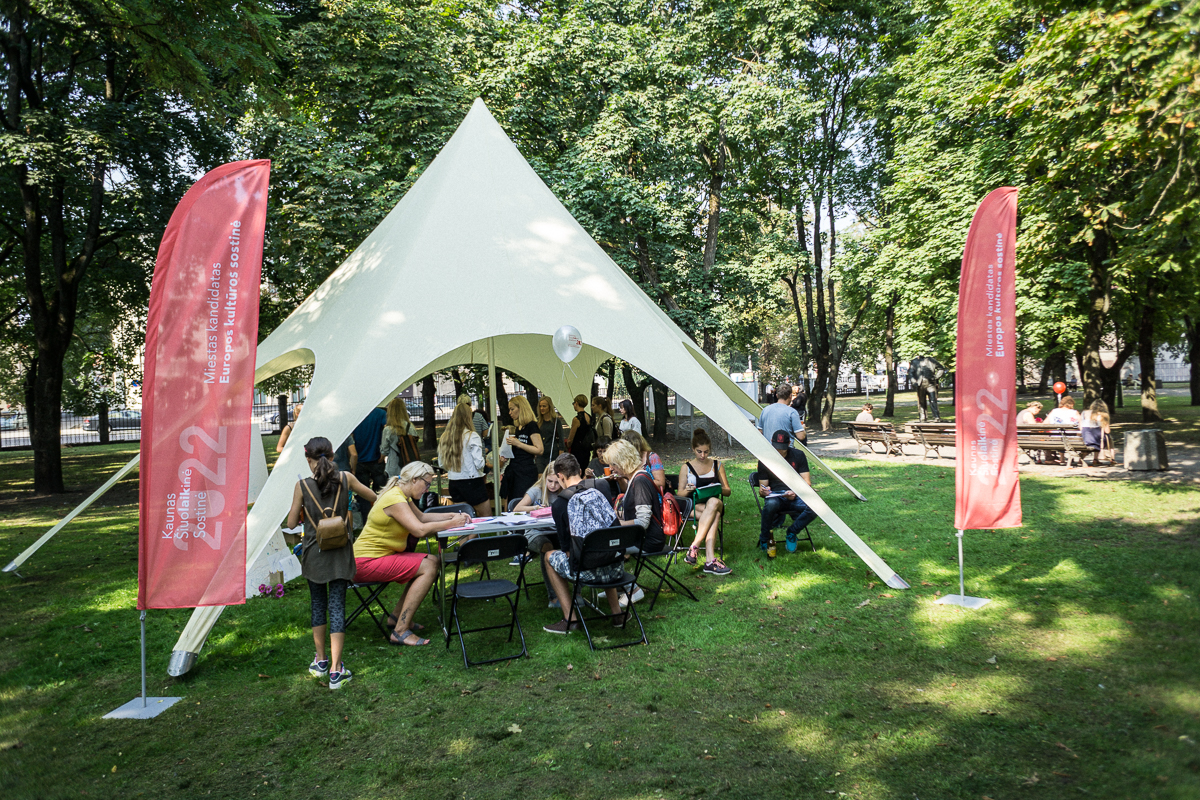This survey was prompted by the participation of Kaunas city and district in the contest for European Capital of Culture 2022 title, and the purpose is to understand the cultural climate in various city and district territories. The survey was conducted live, during public events and community gatherings („ECOC communities laboratory”, Kaunas Autumn Fair, Šančiai micro-district community celebration „Šančinės“, etc.), interviewing the residents live (we are grateful to the ECOC volunteer team, the students of the VMU Faculty of Arts and Department of Public Communication for help), as well as online (the link to the online questionnaire: https://docs.google.com/forms/d/e/1FAIpQLSegFvLlyRmUpu3O9bzcB_Zw08upvn5h_65fofuPGSLwPsnz1g/viewform
The total number of the respondents who answered the survey questionnaire is 1,473, out of them 76 percent are women, and 24 percent are men. Age groups include: 8 percent of minors, 31 percent of 18-30-year-olds, 41 percent of 31-50-year-olds, 16 percent of 51-64-year-olds, and 5 percent are over 65 years old. The survey involved the residents of all 11 Kaunas city micro-districts (Aleksotas – 90, Dainava – 177, Eiguliai – 138, Gričiupis – 48, Centre – 154, Žaliakalnis – 176, Panemunė – 42, Petrašiūnai – 67, Vilijampolė – 51, Šilainiai – 176, Šančiai – 141), as well as the residents of various Kaunas district Elderships (Garliava – 87, and other districts – 126).
You can find the survey summary below.
CULTURAL, SOCIAL, AND EDUCATIONAL CENTRES IN THE ELDERSHIPS
37.1 percent of respondents said they do not use any social, cultural, or educational centres in their micro-district (if the answers of Centre Eldership are excluded, this part of the population reaches 42 percent, and when only the results from the residents of Centre Eldership are taken into account – the percentage of inactive people drops down to 12.8 percent). It was observed that the residents who have recently settled in an eldership (1-5 years ago) and youth (18-30-year-olds) tend to use the aforementioned centres less– respectively 53.6 percent and 53 percent said they do not use any cultural, social, or educational centres in their eldership.
The portion of the city population that uses any type of centres amounts to 62.9 percent in the survey. The most popular institutions among the residents who visit social, cultural, and educational centres are: library (42.5 percent), school or kindergarten (28.2 percent); community or cultural centres (12.5 percent), museums (8.2 percent), day care centres (2.1 percent), and other institutions are mentioned less often. The trend is likely the result of the well developed networks of Kaunas Municipality Vincas Kudirka Public Library (20 territorial subdivisions and 5 specialised divisions) and Kaunas District Public Library, as well as smaller density of cultural centres (e.g. Šilainiai micro-district has only one non-commercial leisure space – Šilainiai library covering the population of 55 thousand Šilainiai residents), and museums (the majority is located in the city centre, with a small portion in Žaliakalnis, and several in other elderships of the city and district).

The survey respondents rated the cultural, social, and educational centres operating in the elderships according to the proposed rating scale:
39.3 percent thought that they stimulate activity, 25.7 percent thought that they are boring, the remaining 35 percent gave an average rating;
44.9 percent of the respondents thought that the centres are cosy, 23.4 percent thought that they are uncomfortable, the remaining 31.7 percent gave an average rating;
52.5 percent of the respondents claimed that they are open, 19.8 percent claimed that they are closed, the remaining 27.6 percent gave an average rating;
37.1 percent felt that these centres are engaging, 24 percent felt that they are unpleasant, the remaining 38.9 percent gave an average rating;
41.4 percent stated they felt that these centres are homely, 23.4 percent felt that they are alien, the remaining 35.2 percent gave an average rating.
To the questions about the activities organised in the elderships, the respondents answered that they consider:
the activities in their elderships as communal – 33.5 percent, individual – 35.5 percent, 31 percent gave an average rating;
34.1 percent said that the activities are interesting, 33.8 percent said they are not interesting, 32.1 percent gave an average rating;
35.5 percent think that the activities are traditional, 31.1 percent think that they are instantaneous, 33.4 percent gave an average rating.
CULTURAL ACTIVITY IN THE MICRO-DISTRICTS
The vast majority of the responses indicates that the respondents see the cultural life of their elderships as too poor. 62.1 percent of survey participants reported that they have to leave their micro-district to have leisure time, and 62.7 percent disagreed with the statement that the cultural life of their micro-district is as interesting as elsewhere in the city. The majority indicated that they experience the lack of events in their micro-district (68.4 percent). The majority of the respondents find events of their interest only in the Centre of Kaunas (67.4 percent), however, they believe that their own micro-district could be a great place for creative activities (55.8 percent).

NEIGHBOURHOOD ACTIVITY
The majority of the respondents believe that they are personally responsible for the life of their neighborhood (62 percent agree with this), a number of respondents (49.4 percent) indicated that they speak with their neighbours about personal subjects, fewer people said they visit each other (37.1 percent), however, the majority of survey participants did not regard themselves as active in the community (53.1 percent), and do not meet their neighbours to socialize in public places (64.6 percent).

50.5 percent of the respondents took part in at least one neighbour meeting in the past year (46.9 percent said they did not participate, and 2.6 percent were unable to answer the question), however, the respondents are less involved in communal events or gatherings: 34.2 percent were involved in at least one community event in the past year (63.7 percent did not attend, 2.1 percent were unable to answer the question).
LOCAL ENVIRONMENT, PUBLIC SPACES, AND ARCHITECTURE
When evaluating their eldership environment and the quality of public spaces, the respondents stated as follows:
47.5 percent of the respondents see the environment of their residence place as attractive, 32.2 percent see it as boring, the remaining 20.3 percent gave an average rating;
52.6 percent thought that it is tidy, 21.5 percent thought that it is untidy, the remaining 25.9 percent gave an average rating;
37.2 percent of the respondents saw it as colourful, 36.7 percent saw it as grey, the remaining 26.1 percent gave an average rating;
53.1 percent regard it as comfortable, 21.9 percent see it as uncomfortable, 25 percent gave an average rating.

SPECIFIC CASES
Out of the 11 city elderships, Vilijampolė and Centre Elderships stood out in their answers.
In the overall statistical background, Vilijampolė case shows considerably higher than the average population’s dissatisfaction with the current cultural offer and the environment. Even 61 percent of the respondents indicated that the cultural, social, and educational centres in the micro-district are uncomfortable; 53.7 percent said that the centres are closed, 55 percent said that they are more unpleasant than engaging. Reflecting on their living environment, 67.5 percent of the respondents answered that it is boring, 56.4 percent said that it was grey. Even 81 percent agreed with the statement that in order to spend their leisure time they often have to leave their micro-district and 87.5 percent agreed that there is a lack of cultural events in their micro-district.
The public opinion of Centre Eldership about the cultural services in their micro-district is significantly higher than of the other districts. This confirms the general opinion of survey respondents that the vast majority of interesting events takes place in the Centre. Only 21.5 percent of the respondents from the Centre said they have to leave their district to spend leisure time. 21.9 percent believed that their area could have more cultural events. 59.7 percent agreed with the statement that only Centre Eldership stands out in the landscape of the events of their interest. When evaluating cultural, educational, and social centres in their micro-district, 54.9 percent said that they stimulate activities, 57 percent said that they are open. The residents of Centre show more favourable assessment of their living environment: 76.5 percent assess it as attractive.

